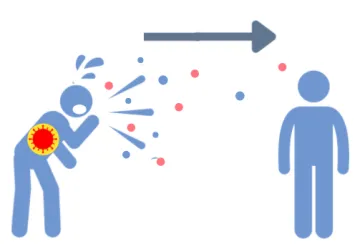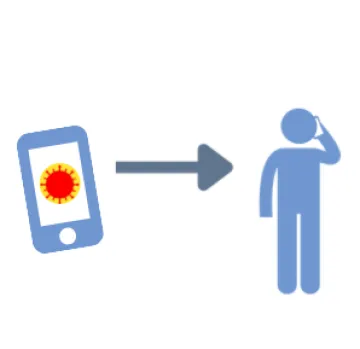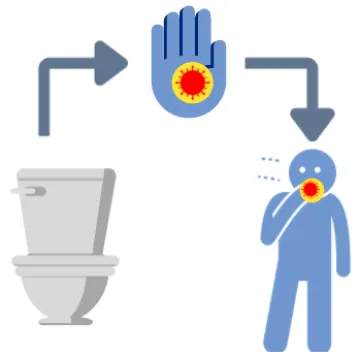What You Need to Know-Week of September 14th
The most important weekly updates for you to keep your community healthy

In this Update:
1. Latest Developments: Airborne transmission
2. Kids and COVID-19: Healthy Eating in a Pandemic
3. Quick Question: Can you get COVID-19 twice?
1. Latest Developments: Airborne transmission
COVID-19 has the potential to spread a few different ways: use the table below to understand these types of transmission:
| Type of Transmission | What is it? | How does someone become infected? | How likely is someone to become infected? | Ways to reduce risk: |
|---|---|---|---|---|
|
Airborne
Image
|
Airborne transmission occurs when very small respiratory particles produced through talking, sneezing, coughing, breathing, etc. get suspended in the air for longer periods of time. These particles can travel across longer distances compared to larger respiratory droplets. Discussions about airborne transmission of COVID-19 have been ongoing amongst the scientific community. Scientific evidence is building to support that the virus may spread through airborne particles under specific circumstances. |
This route of transmission occurs most often in indoor and poorly ventilated environments where individuals are not wearing masks. Activity that increases the small particles getting into the air such as singing, shouting, coughing, or breathing hard during exercise can increase the chance of airborne transmission. Airborne transmission has the potential to infect more people because the small, aerosolized viral particles can linger in the air longer (sometimes up to several hours), meaning more people could potentially breathe them in for long enough to cause an infection. |
Likely under certain circumstances: Indoor, poorly ventilated areas, where people are not wearing masks. When particles are airborne being six feet away indoors may not be enough to keep you safe. |
Open a window Everyone wears a mask Take activities that increase particles outdoors if possible AND wear a mask Avoid crowded indoor spaces Avoid indoor spaces where people do not wear masks Remember risk increases with longer exposure to the virus – reduce time in indoor spaces that may be unsafe |
|
Respiratory Droplets
Image
|
The virus spreads mainly through large respiratory droplets, which are produced through talking, sneezing, coughing, breathing, etc. These respiratory particles are much bigger than airborne particles, and so they usually fall to the ground quickly. |
The longer you are close to people the higher the chance of transmission. Risk is considered higher for people who have been within 6 feet of others for 15 minutes or more but transmission can occur even in shorter time periods if you are very close, without masks or near someone talking, sneezing, coughing, or singing. | Likely: The virus is most commonly spread this way. |
Wear masks Keep your distance from people outside your household Space out as much as possible when around other people Don’t panic if you walk within several feet of someone at a store or on a sidewalk – remember risk increases with longer durations. Just make sure you exit all unsafe situations as quickly as possible. |
|
Contaminated objects or surfaces
Image
|
Another way the virus spreads is through contact with contaminated surfaces or objects such as doorknobs, elevator buttons, and cell phones. It is hard to prove if someone got infected from a contaminated surface but scientists have found virus on surfaces in hospital rooms indicating this mode of transmission is less likely to occur, but is still possible. | For a person to become infected through this route, they would need to touch a surface or object that has enough virus particles (usually from respiratory droplets) on it to cause an infection and then touch their eyes, nose, or mouth. | Less likely: The virus is less likely to spread this way. Remember that dose from a surface is likely less than being in direct contact with someone infected. |
Avoid touching things like door handles, light switches, or other surfaces many other people may touch. Consider carrying a Q-tip to punch in the numbers on high touch credit card machines and dispose of it afterwards. Environment note: You can get ones that decompose to be friendly to the environment. Carry hand sanitizer and sanitize your hands if you have been in public. Wash your hands as soon as you get home. Packaging from stores is thought to be very low risk, but if you are worried about packaging from a store – remember to never use disinfectant on food products. It is not safe. Wash with soap and water instead. |
|
Other body fluids Image
|
There is evidence that the virus that causes COVID-19 can be found in body fluids other than respiratory droplets, such as urine or feces. In fact testing wastewater for viruses is one way we can track the virus in the community. |
There have been no published reports of cases that have been caused by contact with an infected person’s urine or feces. | Unlikely: There have been no documented cases through this route of transmission. |
Good hygiene practices are always important. Wash hands after using the restroom or changing diapers. If you are cleaning bathrooms outside your household or when someone is sick at home, take extra precautions and wash your hands. |
What does airborne transmission mean for COVID-19 prevention guidance?
- Preventative guidance may change as more scientific evidence is gathered about airborne transmission for COVID-19. However, the major ways to avoid this route of transmission are to:
- Wear cloth face coverings
- Avoid poorly ventilated, indoor spaces
- Reduce your time spent indoors with members who are not a part of your household
2. Kids and COVID-19: Healthy Eating in a Pandemic
Feeding your children nutritious food is important, but setting realistic goals and being patient with both yourself and your child is equally important. There is no right or wrong way to manage your time, your lives, or your stress levels right now. There is only you, doing your best, whatever that looks like.
We have gathered together minimal-effort suggestions to help you take small steps to add healthy options into your child’s diet.
Go Back to Basics – You don’t need to be fancy to be healthy!
- Build your kids’ meal around 4 basic elements (but if they’re not all there every meal, that’s okay, too!):
- 1 protein (dairy/meat/eggs/beans/nuts/seeds)
- 1 vegetable (anything your kid will eat)
- 1 fruit (fresh, frozen, or dried)
- 1 whole grain (bread, tortilla, rice, oatmeal, cereal)
- A few meal examples:
- Waffles (whole grain, frozen are just fine) + peanut butter (protein) + berries
- Vanilla yogurt (protein) + banana (fruit) + granola (whole grain)
- Smoothie with yogurt (protein) + strawberries and bananas (fruit) + canned sweet potato (veg)
- Bonus: freeze leftovers into healthy popsicles if you have molds or ice cube trays
- Whole grain bread (whole grain) + turkey (protein) + carrot sticks (veg) + apple slices (fruit)
- Whole wheat tortilla or english muffins or pizza crust (whole grain) + cheese (protein) + tomato sauce (veg) + orange wedges (fruit)
- Tacos with corn tortillas (whole grain) + beans and taco meat (protein) + corn and/or tomatoes and/or lettuce (veg)
- A few snack examples:
- Low-fat cheese, hard-boiled eggs, popcorn, Greek yogurt, fresh veggies (broccoli and cauliflower florets, zucchini and cucumber slices, celery, carrot or bell pepper sticks, cherry tomatoes, even rolled up lettuce leaves, etc.) with dip, fruits, nut/seed crackers, deli meat.
- A few drink examples:
- Milk, plant-based milk alternatives, sparkling water (add a splash of juice for flavor!), kombucha, coconut water, tea (hot/cold, decaf, unsweetened)
- For tons of resources, visit USDA Myplate
Minimize Effort – Get the most from healthy options with the least input!
- Focus on one meal per week, or just breakfasts, or just snacks… Find what works best for you to take some pressure off the rest of the day or week. Making a big pot of soup on a Sunday can be a time saver the rest of the week.
- Help your kids be self-sufficient during the day while you’re working by packing their lunch the night before and pre-portioning snacks that they can grab during the day.
- Put easy-to-grab snacks front and center on your counter or in your fridge and hide those treats.
- Don’t get creative, get predictable: have breakfast for dinner, taco Tuesdays, and fish stick Fridays – whatever is easy and familiar!
Get Them Involved – Your kids may enjoy this grown-up topic!
- Have conversations with your kids about why healthy foods are important and they may be more likely to buy in.
- Make different snack options available so that your kids feel empowered to choose for themselves.
- Ask your kids for fruits, vegetables, and snacks that they want to eat before you go shopping so they feel involved and may be more likely to eat them.
- Build-your-own meal “bars” are great! Lay out all the topping options and let your kids choose for themselves what they want: tacos, burrito bowls, nachos, baked potato or sweet potatoes
Resources – If you are having difficulty getting healthy foods, there may be support available
- For up to 60lb of rescued produce for only $10, Market on the Move has distribution sites around Tucson, Phoenix, and Northern Arizona. Find out more here
- Contact Arizona 2-1-1 (dial 2-1-1 on your phone or visit 211 Arizona for assistance with a wide variety of services, including food, shelter, utilities, and more.
- To find out if you qualify for Supplemental Nutrition Assistance Program (SNAP) benefits, formerly known as food stamps, please visit Health-E-Arizona, a service of the Department of Economic Security (DES)
- Many schools in Arizona are offering free grab-and-go for anyone younger than 18, regardless of attendance at that school. To find a school near you and learn more, please visit AZ HealthZone
- For an interactive map of services in your community that are providing healthy meals, please visit No Kid Hungry or text the word “FOOD” to 877-877
- To find your nearest food bank and more information on how the foodbank can help you, please visit AZ Food Banks Network or call call 602-528-3434 or 1-800-445-1914
- If you are able and want to help you can donate to one of the foodbanks in your community.
If your family is not struggling with food insecurity, please consider supporting a local food shelter. To find a food shelter near you and how you can help, please visit Feeding America
Take Away:
During times of heightened stress, it is important to focus on what feels achievable and to give yourself and your child room to cope and manage stress as best you can. And with the return to school this fall looking different from anything we’ve ever known, there are a lot of reasonable questions and worries.
There may be times when stress levels even out and you and your child can begin to adjust to a new normal. This may take time, but eventually you may be able to shift your focus from navigating online classes to other aspects of your child’s well-being. It is during these times that you may have the opportunity to think about nutritious food and healthy snacks, particularly as home schooling means a lot more meals to provide–with, or without, the support of meals from your child’s school(s).
3. Quick Questions: Can you get COVID-19 twice?
Much more research is needed before reaching any scientific conclusions regarding immunity for COVID-19. It appears that it is unlikely that someone could become reinfected with the virus in a short period of time (e.g., 3 months after their initial infection). However, there are several accounts of reinfection that occured 3 months or more after patients had fully recovered from their first viral infection.
- One possible reason for that reinfection might occur is viral mutation. Viruses, like ones that cause the common cold or the flu, can mutate. Coronaviruses, like the ones that cause COVID-19 mutate more slowly than the virus that causes flu. Most of the mutations of the virus so far appear to be small changes. There is one mutation of the SARS-CoV-2 virus that seems to have made it more transmissible but not cause more serious disease. There is the possibility that the virus could mutate into different strains that people’s immune systems have not been exposed to during their first infection. However, at this point, more research is necessary in order to understand how viral mutations affect individuals’ susceptibility to reinfection of COVID-19.
The next update will cover information about how to stay safe in close living quarters. If you would like to learn more about this and other topics related to COVID-19 in Arizona, please complete next week’s AZCOVIDTXT survey that you will receive via text in about a week.




